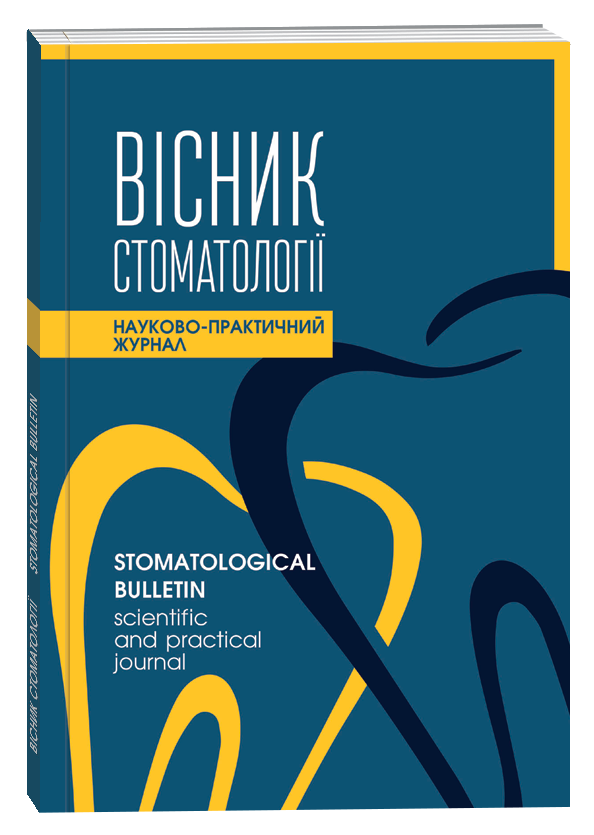ANALYSIS OF X-RAY FEATURES OF THE LOCATION OF IMPACTED TEETH IN THE EXAMINED PATIENTS
DOI:
https://doi.org/10.35220/2078-8916-2019-33-3-47-53Keywords:
impacted teeth, mixed dentition, permanent dentition, orthopantomographyAbstract
Introduction. In the algorithm of examination of patients with impacted teeth, it is mandatory to determine the po-sition of the axis of the impacted tooth in the jaw and rel-ative to the axis of adjacent teeth, the state of the alveolar bone, the age of patients and their somatic status. The success of treatment depends directly on determining the diagnosis and qualification of the doctor.
The purpose of the study. To analyze the x-ray features of location of the impacted teeth to determine the necessary complex of diagnostic and treatment measures in case of the detection of the impacted teeth.
Materials and methods. A total of 109 patients between the ages of 9 and 35 were examined. Age distribution cor-responds to the gender percentage of the population. X-ray techniques included dental intra-oral radiography, orthopantomography, CT.
Results of the study and their discussion. When deter-mining the depth of location of the impacted teeth (in permanent and mixed dentition) it was found that most of them are located at the I and II levels. The topographic location of the impacted teeth depending on their anato-my (buccal or oral) was revealed. Thus, for the impacted central incisors the vestibular position significantly ex-ceeds the palatine (81.3±9.4; 18.7±2.2; p<0.01); for the canines the vestibular position (81.3±9.4); 18.7±2.2; p<0.01), first (20.0±1.9; 80.0±7.5; p>0.01) and second premolars (38.1±3, 5; 61.9±9.2; p>0.05) are placed in a significantly higher percentage of orally. When determin-ing the inclination angles of the impacted teeth, it was found that the majority of the teeth were located at the medial angle to the occlusal plane – 59 (52.2±7.5 %) found on the upper jaw. The distribution by type of reten-tion revealed that the vertical position of the impacted teeth, that is type I, is typical for most patients of 30.2±3.5 % of teeth.
Conclusions. This distribution of impacted teeth accord-ing to the described types relieve the planning of the nec-essary complex of diagnostic and treatment measures and can be the basis of algorithms for therapeutic measures in the case of detection of impacted teeth.
References
Алгоритм розшифрування ортопантомограм / Н.В. Головко, С.В. Головко, Д.М. Король [та ін.] // Український стоматологічний альманах. − 2006. − Т.2, № 1. – С. 9−11.
Воробьев Ю.И. Рентгенодиагностика затруднен-ного прорезывания и неправильного положения зубов / Ю.И.Воробьев, В.П.Трутень // Стоматология. – 1997. – Т. 76, № 3. – С. 61−63.
Жигурт Ю. И. План и прогноз лечения при ретен-ции зубов: автореф. дис. на соискание учен. степени канд. мед. наук: спец. 14.01.22 "Стоматология / Ю. И. Жигурт. – М., 1994. – 19 с
Клемин В. А. Тактика ортодонта при ретенции от-дельных зубов / В.А. Клемин, Л.В. Яворская, В.М. Лаври-ненко // Український стоматологічний альманах. – 2007. − № 2. – С. 37−40.
Современные методы обследования пациентов с ретенцией клыков верхней челюсти / А.Д. Волчек, И.Г. Го-лубева, Н.А. Рабухина [и др.] // Ортодонтия. – 2006. – №1. – С. 24-26
Ославський О.М. Обґрунтування методів ком-плексного лікування скупченого положення зубів: автореф. дис. на здобуття наук. ступеня канд. мед. наук : спец. 14.01.22 ”Стоматологія / О. М. Ославський. – Одеса, 2007. – 18 с.
Пилипів Н.В. Особливості топічного розташуван-ня ретенованих зубів і їх систематизація / Н.В.Пилипів // Український стоматологічний альманах. – 2013. – №4. – С. 64 - 68
Felicita A.S. Orthodontic management of a dilacer-ated central incisor and partially impacted canine with unilateral extraction – A case report / A.S. Felicita // The Saudi Dental Journal. – 2017. – Vol. 29(4). – P. 185–193.
Bedoya M.M. A review of the diagnosis and man-agement of impacted maxillary canines/ M.M. Bedoya, J.H. Park // J Am Dent Assoc. – 2009. – Vol. 140(12). – P. 1485-93.
Use and Evaluation of a Cooling Aid in Laser-Assisted Dental Surgery: An Innovative Study / S. Bernardi, S. Mummolo, K. Zeka [et al.] // Photomed Laser Surg. – 2016. –Vol. 34 (6). – P. 1–5.
Age-related changes in the Brazilian woman’s smile/ L.N. Correia, S.A. Reis, A.C. Conti [et al.] // Braz Oral Res. – 2016. – Vol. 30(1):e35.
Impacted and transmigrant mandibular canines inci-dence, aetiology, and treatment: a systematic review / D. Dalessandri, S. Parrini, R. Rubiano [et al.] // European Journal of Orthodontics. – 2017. – Vol. 39(2). – P. 161-169.
Ericson S. Resorption of incisors after ectopic erup-tion of maxillary canines: a CT study / S. Ericson, J. Kurol // Angle Orthod. – 2000. – Vol. 70. – P. 415-23.
Frequency of impacted teeth and categorization of im-pacted canines: A retrospective radiographic study using orthopantomograms / H. Al-Zoubi, A. Alharbi, D. Ferguson [et al.] // Eur J Dent. – 2017. – V. 11 (1). – P.117-121.
Modi P. Smart sliding hook as a ready to use auxiliary in orthodontist’s inventory/P. Modi, S. Aggarwal, P. Bhatia// Singapore Dent J. – 2016. – Vol. 37. –P.27-32.
Pignoly M. Reason for failure in the treatment of im-pacted and retained teeth / M. Pignoly, V. Monnet-Corti, M. Le Gall // Orthod Fr. – 2016. –Vol. 87(1). – P.23-38.
Radiographic predictors for maxillary canine Impac-tion/A. Alqerban, R. Jacobs, S. Fieuws [et al.] // Am J OrthodDentofacialOrthop . – 2015. – Vol. 147. – P. 345-54.
Stivaros N. Radiographic Factors Affecting the Man-agement of Impacted Upper Permanent Canines / N. Stivaros, N. A. Mandall // Brit. J. Orthodont. − 2000. − Vоl. 27(2). − Р. 169−173.
Three-dimensional Localization of Impacted Canines and Root Resorption Assessment Using Cone Beam Computed Tomography/E. Almuhtase, J. MAO, D. Mahony [et al.] // J Huazhong Univ Sci Technol. – 2014. – Vol. 34(3). – P. 425-430.









